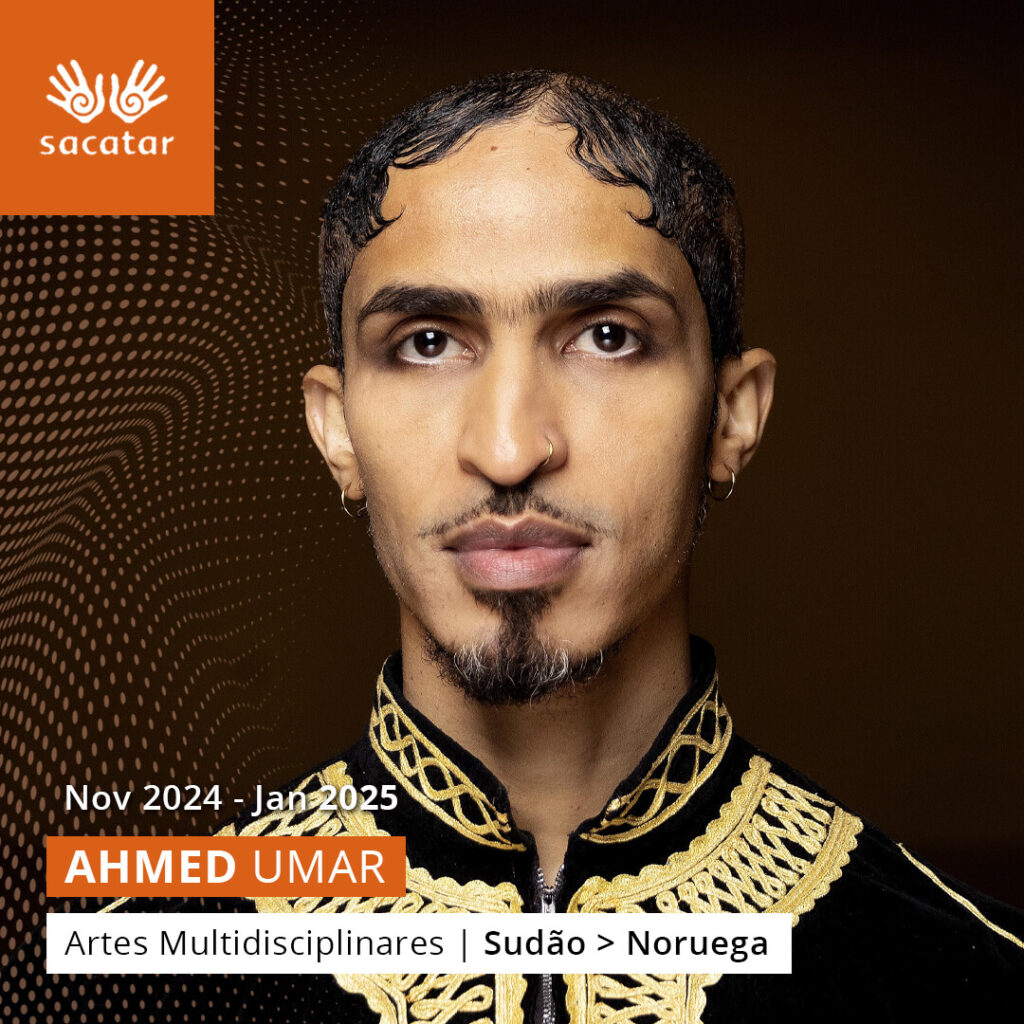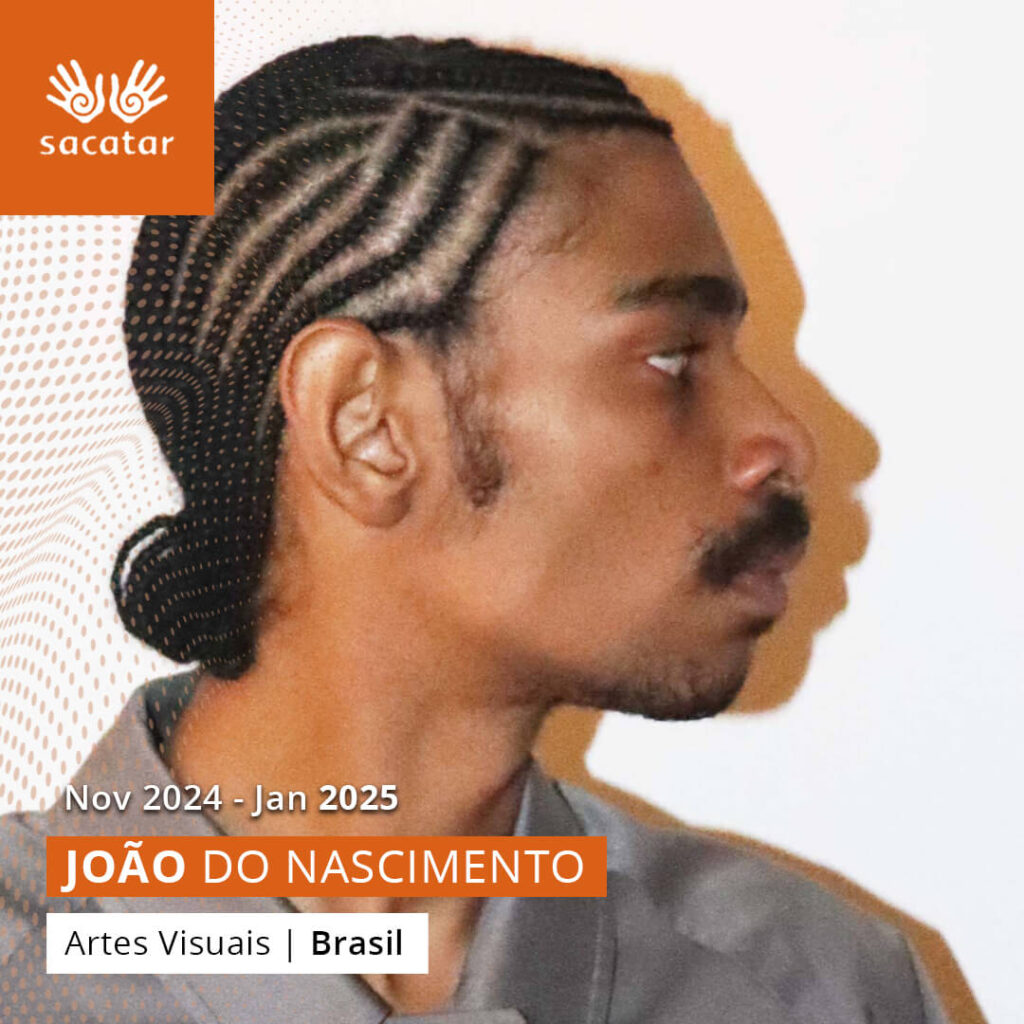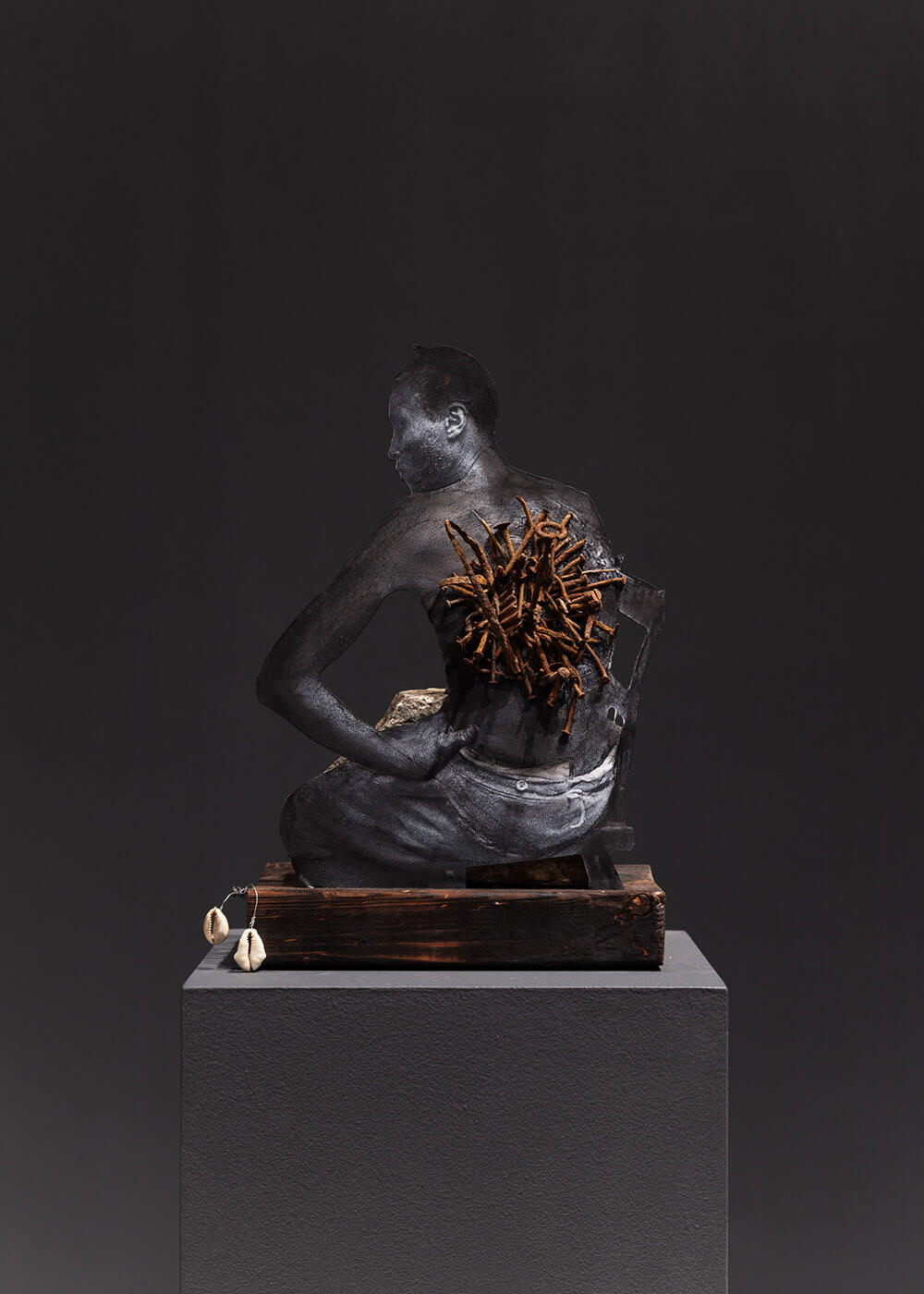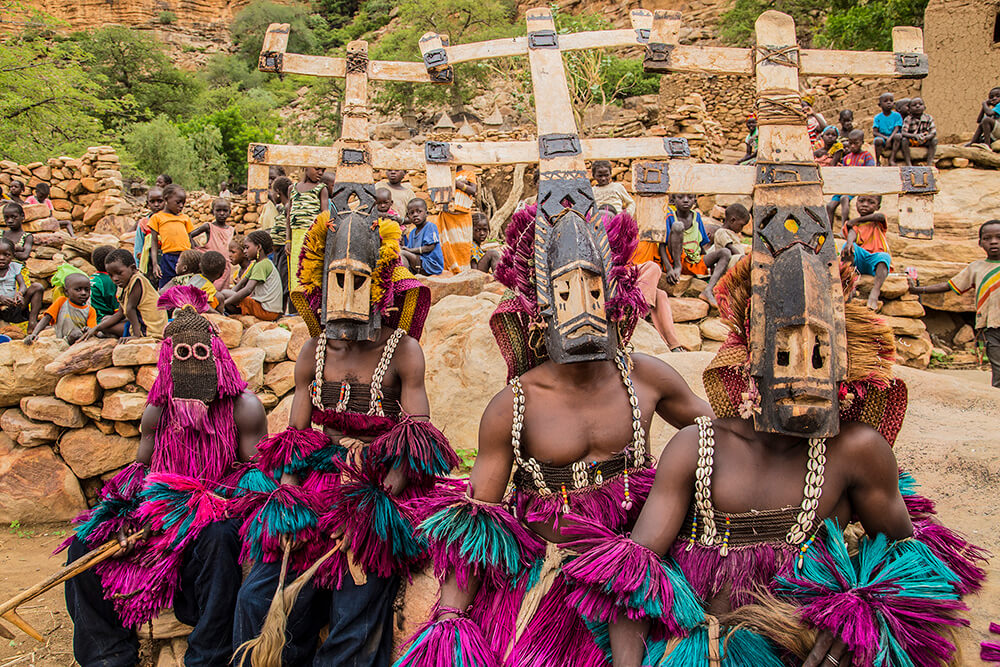We are currently on our annual break. The next group of residents will arrive on March 17th, 2025 and will be announced here.
Our latest fellows: The following artists were in residence at Instituto Sacatar on the island of Itaparica, Bahia, Brazil, from November 18, 2024 to January 20, 2025.
To be an artist in the world, to be an artist in Bahia:
Artists at Sacatar Redefining Narratives, Identity,
and Belonging.
Sacatar welcomes a new group of resident artists starting on November 18th!
Born in Sudan and based in Norway, artist Ahmed Umar takes an intersectional approach that bridges the personal, cultural, and spiritual realms. Umar is one of the most prominent advocates for queer Muslims, and his work addresses identity and belief systems, as well as suppression and self-empowerment. He is one of the artists featured in this year’s Venice Biennale.
Iva Radivojević, a renowned filmmaker and artist originally from Belgrade, creates works that poetically reflect migration, displacement, and belonging. Her films have been screened at major international festivals and her accomplishments include a Guggenheim Fellowship.
João do Nascimento is an artist from Porto Seguro, Bahia, who explores the representations of the Black body, blending self-representation with African cosmology. In his work, he creates hybrid forms that reflect the social, spiritual, and material dimensions rooted in Afro-Brazilian culture. João do Nascimento’s residency is supported by the Fundo de Cultura Para Ações Continuadas da Secretaria de Cultura do Estado da Bahia.
Luma Nascimento, artist and educator, explores Afro-Brazilian culture and spirituality through symbols of trade, memory, and ritual. Focusing especially on glass beads, her work activates ancestral memories, fostering dialogue about Afro identity in contemporary contexts. Originally from Salvador, Bahia, Luma Nascimento’s residency is supported by the Fundo de Cultura Para Ações Continuadas da Secretaria de Cultura do Estado da Bahia.
The Nigerian-Canadian artist Oluseye Ogunlesi draws inspiration from Yoruba philosophy. From this foundation, he creates “diasporic debris,” transforming found objects into artworks that reflect African spirituality, the Black diaspora, and mysticism. His work celebrates Black identity as timeless and transcendent.
Paola Barreto, from Brazil, is an artist and researcher focused on resisting erasure in the context of modern technologies and surveillance. Her work, which has been featured in institutions like the Venice Biennale, MAM-SP and Transmediale Berlin, includes urban interventions and audiovisual projects.
Acclaimed author Snowden Wright, known for “American Pop” (a Wall Street Journal WSJ+ Book of the Month and NPR Best Book of the Year), will use his time at Sacatar to delve into narratives about civil-war era US Southerners in Brazil. He will also use the experience of the residency as an opportunity to draw inspiration from other artists and disciplines.
Coming from Bamako, Mali, artist, filmmaker, and photographer Tiécoura N’Daou will explore possible connections between Mali and Bahia in the context of Zambiapunga. A specialist in Malian traditional cultures, the artist will create an experimental documentary and a photographic series. Tiécoura N’Daou’s participation is supported by the Fundo de Cultura Para Ações Continuadas da Secretaria de Cultura do Estado da Bahia.
Sacatar extends its gratitude to the Fundo de Cultura para Ações Continuadas da Secretaria de Cultura do Estado da Bahia (SECULT) for supporting the residencies of Bahian artists Luma Nascimento and João do Nascimento, as well as the participation of Malian artist Tiécoura N’Daou in the residency program.
These artists will be in residence at the Instituto Sacatar from November 18, 2024 to January 20, 2025. For complete information about each artists and their respective projects for this session, please see below:

AHMED UMAR
Multidisciplinary Arts
Sudan > Norway
Sudanese-born artist Ahmed Umar is a cross-disciplinary creator based in Norway. He earned his MFA in Medium and Material-Based Art from the Oslo National Academy of the Arts in 2016. Umar is a prominent advocate for queer individuals with Muslim backgrounds in both Norway and Sudan.
Umar’s artistic practice engages with themes of identity, religion, and cultural values, drawing from his personal experiences to explore narratives of suppression, alienation, liberation, and self-empowerment. His work spans various media, including sculpture, textiles, ceramics, jewelry, photography, and performance, reflecting the complexity of the stories he seeks to tell.
During his residency at Sacatar, Umar aims to delve into the influence of Black African spirituality on local rituals and dance, investigating how these elements shape community identity and serve as expressions of resilience, storytelling, and cultural continuity. His goal is to deepen his artistic engagement with spiritual themes through immersive, firsthand experiences.


IVA RADIVOJEVIĆ
Moving Image
Serbia > Greece
Born in Belgrade, Iva Radivojević spent her early years in Yugoslavia, Cyprus, and NYC. She is an artist and filmmaker who currently divides her time between Athens and Lesvos. Her films have screened at the New York Film Festival, New Directors/New Films, Rotterdam IFF, CPH, Berwick Film & Media Arts Festival, DocLisboa, Museum of Modern Art (NYC), Thessaloniki Biennale of Contemporary Art, and were commissioned by ARTE La Lucarne and Field of Vision. She is a recipient of the Sundance Art of Non-Fiction Fellowship, Guggenheim Fellowship, Jerome Fellowship, NYFA Fellowship, and Princess Grace Special Project Award.
Radivojević’s practice emerges as a collection of fragments—observations, poetry, images, sounds, melodies, and languages. Her work often circles themes of migration, displacement, and belonging, seeking connections to the metaphysical or magical.
At Sacatar, Radivojević will explore the notion of dislocation and Dubravka Ugrešić’s concept of “dreamscape” while developing a written companion to her film “When The Phone Rang”. The plan is to research and write an essay analyzing Ugrešić’s idea of exile’s dreamlike structure, reflecting on exile, nostalgia, memory, and their connections to storytelling.


JOÃO DO NASCIMENTO
Visual Arts
SECULT
Brazil
João do Nascimento’s research explores the representation of a subjective Black body through mediums such as painting, objects, installations, and text. Born in Porto Seguro, Bahia, Nascimento graduated from the Escola de Belas Artes at UFBA and has participated in national exhibitions such as Sidney Amaral: Um Espelho na História and Direito à Forma at the Inhotim Institute.
João do Nascimento uses self-representation as a way of imagining the body in its entirety. By considering the body in its social, spiritual, and material dimensions, he creates hybrids that evoke African cosmology, where hybrid beings can represent messages, deities, ancestors, or metaphors.
During his residency at Sacatar, in addition to his studio work, the artist plans to lead the workshop “Collage and Anatomy” for students in Itaparica. The workshop proposes a didactic approach to reflect on curation, references, and composition through the exercise of creating a body inspired by the concept of the “body-world,” an element the artist emphasizes as central to African philosophy.
João do Nascimento’s residency is supported by the Secretary of Culture of the State of Bahia – SECULT through the Fundo de Cultura Para Ações Continuadas da Secretaria de Cultura do Estado da Bahia.


LUMA NASCIMENTO
Multidisciplinary Arts
SECULT
Brazil
Luma Nascimento is a multidisciplinary artist, art director, and educator with a degree from the State University of Bahia. She also studied glassblowing and manipulation in Pretoria, South Africa, at the Glass Forming Academy, and is the creator of “Lemoriô – Ilê de Miçangas”. Currently serving as vice president of the traditional Bloco Afro “Os Negões”, she participated in the CAPACETE + MAM Rio 2020 artist residency, where she published the chapter “Me Despache_Pra Frente” in the book Esses Seres Vivemos: Residências MAM 2020.
Her work explores the intersection of traditional Afro-Brazilian cultural practices and spirituality, with an outlook that combines vital energy, aesthetics, and memory. Luma Nascimento’s research centers on street markets in various regions of Brazil and around the world, leading her to delve deeply into the study of glass beads. In this context, she investigates the historical complexities of beads, from their use as currency and their ritualistic dimensions to their role as a form of language.
At Sacatar, Luma Nascimento will explore the concept of “BODY AS DOCUMENT” through the languages of Movements and Alternative Societies Organized by Black People, weaving her lived experiences and worldviews into the work. This investigation will incorporate body experimentation, glass fusion, hand modeling, and bead weaving. Through this process, the artist seeks to combine “fragments of memory” to create a sculpture and a video performance.
Luma Nascimento’s residency is supported by the Secretary of Culture of the State of Bahia – SECULT through the Fundo de Cultura Para Ações Continuadas da Secretaria de Cultura do Estado da Bahia.

Cool Hunter Favela + Elloá Amorim / Foto: Juh Almeida

OLUSEYE OGUNLESI
Visual Arts
UK > Nigeria > Canada
Oluseye is a Nigerian-Canadian artist. Using “diasporic debris” — a term he coined to describe the artifacts, discarded materials, and found objects he collects from his trans-Atlantic travels — he explores Black being across themes. These transformational objects are recast into sculpture, performance, and photography, invoking Oluseye’s personal narratives and travels within a broader examination of Black Diasporic culture, migration, and African spiritual traditions.
The artist has exhibited at the Museum of the African Diaspora, San Francisco (2024), Daniel Faria Gallery, Toronto (2024), Southern Guild Gallery, Cape Town (2023), the Gardiner Museum, Toronto (2023), Albright-Knox Museum, Buffalo (2022), Museum of Contemporary Art, Toronto (2021), Agnes Etherington Art Center, Queen’s University, Kingston (2021) and the Art Gallery of Ontario, Toronto (2015).
While at Instituto Sacatar, Oluseye Ogunlesi will continue developing his “Eminado” series, reimagining talismanic objects that people of African origin—past and present—wore for comfort and protection. In this spirit, he has been traveling for six years, collecting “diasporic debris” to honor unacknowledged peoples and histories. At Sacatar, he will collect artifacts from Bahia, combining these with objects previously gathered in Nigeria and other locations.


PAOLA BARRETO
Multidisciplinary Arts
Brazil
Paola Barreto is an artist, researcher, and adjunct professor at UFBA, where she coordinates the Balaio Fantasma Research Group. She has a PhD in Interdisciplinary Poetics from UFRJ, during which she also studied at the University of the Arts Berlin, UdK, in Germany. She holds a post-doctorate in Art History from UFRB and the University of Abomey-Calavi in Benin. She is a permanent member of the PPGAV-EBA and the ProfArtes-IHAC Professional Master’s Program. She has participated in group exhibitions at the Biennale di Venezia, Transmediale Berlin, Live Performers Meeting Room, and MAM-SP, among others.
Paola Barreto’s artistic and creative practice is rooted in critical examinations of the history of modern technologies, intersecting cinema, surveillance, and art studies. She develops projects at the interface of artistic production and critique, focusing on physical and symbolic territories that resist processes of invisibilization or erasure. Her work includes urban interventions, audiovisual projections, transdisciplinary events, publications, and curatorial projects.
Since 2022, Paola has been examining cultural exchanges between Brazil and Benin. In 2023, she traveled there as a post-doctoral researcher and returned in 2024 as a guest artist at the Ouidah Biennial. While at Sacatar, she will engage in dialogue with local communities that sustain traditions connecting African diaspora territories on multiple levels. She’ll then use this material to create a lecture-performance and a video installation.


SNOWDEN WRIGHT
Literature
USA
Snowden Wright is the acclaimed author of “American Pop”, a Wall Street Journal WSJ+ Book of the Month and NPR Best Book of the Year. He has written for The Atlantic, Salon, Esquire, The Millions, and the New York Daily News, among other publications, and previously worked as a fiction reader at The New Yorker, Esquire, and The Paris Review. Wright was a Marguerite and Lamar Smith Fellow at the Carson McCullers Center, and his small-press debut, “Play Pretty Blues”, received the Summer Literary Seminar’s Graywolf Prize. His third novel, “The Queen City Detective Agency”, is forthcoming from HarperCollins.
According to Wright, residencies such as Sacatar allow him to connect with other artists, discuss their crafts, and in doing so, refine his own. For this reason, he highlights the community aspect of the residency as one of its main draws.
While at Sacatar, he intends to work on a novel-in-progress, “True Delta”. Although it is a work of fiction, it concerns a real group from American history: the approximately 10,000 Southerners who, after the Civil War, emigrated to Brazil. The novel centers on the fictional town of New Vicksburg and its residents, who grapple with their “exile” from America and the repercussions—both figurative and literal—of having been on the wrong side of history.


TIECOURA N’DAOU
Moving Image
Mali
Tiécoura N’Daou is a multidisciplinary artist and researcher whose work spans video, photography, and installation. He graduated from the Conservatoire des Arts et Métiers Multimedia in Bamako and today balances his life between research and various experiences in the fields of art, photography, cultural journalism, television, and film production. Deeply rooted in Malian cultures and traditions, he remains attuned to technological advancements, striving to merge tradition with innovation.
He has been in various exhibitions and residencies around the world, including the Biennial of Contemporary Art Sesc_Videobrasil in São Paulo, the African Digital Innovation Festival in Johannesburg, the Rencontres de la Photographie in Bamako, the Dak’Art Biennale of Contemporary African Art, and the Biennial of Contemporary Arts in Reunion Island.
For his residency at the Instituto Sacatar, Tiecoura plans to adopt a cross-cultural approach to the rituals and spiritual practices of the Dogon people of Mali and the Zambiapunga cultural manifestation in Nilo Peçanha, Bahia, Brazil. His goal is to create an experimental documentary and photography series that explores the similarities between these two traditions and peoples.
Tiecoura N’Daou’s residency is supported by the Secretary of Culture of the State of Bahia – SECULT through the Fundo de Cultura Para Ações Continuadas da Secretaria de Cultura do Estado da Bahia.


PRESS RELEASE SEPTEMBER 2024
- Ann Mary Gollifer / Visual Arts / Guyana > UK > Botswana
- Dazaun Soleyn / Dance / USA
- Fernanda Costa / Multidisciplinary Arts / Brazil
- Geralyn Shukwit / Photography / USA
- Hélène Bertin / Visual Arts / France
- Julien Discrit / Visual Arts / France




